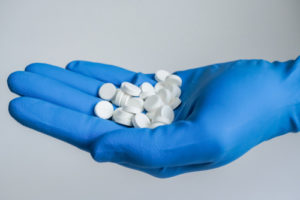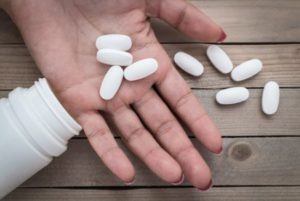Suboxone is a medication commonly used to treat opioid addiction, dependency, and withdrawal symptoms. Unfortunately, Suboxone has a high risk of misuse, and developing an addiction to Suboxone is not as uncommon as you may think. Detox is the first step to begin treating Suboxone addiction, as well as any other substance addiction.
Having the proper knowledge and information about Suboxone detox and Suboxone withdrawal symptoms beforehand can better prepare you for what addiction treatment will be like. Questions like “What are some withdrawal symptoms?” and “What is detox like?” are common among people that are considering seeking suboxone addiction treatment, and rightfully so. As the first step in treatment, Suboxone detox is also the most important.
What Is Suboxone?
The primary objective of a drug like Suboxone is to help reverse the side effects of short-acting opioids, such as prescription pain relievers, heroin, or fentanyl. It helps relieve many of the symptoms you’ll likely face during Suboxone withdrawal. It’s a worthy adversary in treating those going through Suboxone rehab, reducing the cravings to cause relapse. It consists of two ingredients, naloxone and buprenorphine. Although the Suboxone withdrawal timeline will vary from one person to the next, introducing a drug like Suboxone is beneficial at easing the process and keeping the person from relapse.
Although Suboxone withdrawal symptoms can also be serious, the drug is still highly regarded throughout the recovery community. Because it contains a combination of naloxone and buprenorphine, it is a partial opioid agonist that blocks opiate receptors and reduces short-acting opioid withdrawal to help cravings. Naloxone reverses the effects of opioids, meaning if you ingest oxycodone while on Suboxone, you will not feel the oxycodone. When used in conjunction with one another, withdrawal becomes a much more manageable process, and the relapse rate should decrease.
In fact, Suboxone has become the preferred treatment medication in the fight against opioid addiction. Another common drug, methadone, has slowly been phased out by Suboxone. However, methadone may be a better option in some cases. Still, because it can produce a high, it should only be used if all other options have been exhausted. Methadone can also become habit-forming, so proceed with caution.
Unlike other opioid replacement drugs that need a prescription from a treatment center, your doctor can prescribe Suboxone. This drug is commonly given at the beginning of treatment and throughout treatment. In some cases, it may be taken after treatment during recovery.
Suboxone can be used for as long as a specialist sees fit. As long as you avoid drugs, it’s a safe and effective way of safeguarding and managing your sobriety. Although Suboxone can help you manage your symptoms that stem from withdrawal, it’s important to remember it has some opioid characteristics, meaning a chemical dependence is possible. When you become chemically dependent on any drug, you’re at a higher risk of developing withdrawal symptoms.
If you’ve reached a point where you want to be completely drug-free, it’s important to understand what to expect during Suboxone withdrawal and Suboxone detox. In some cases, you may need a stint in Suboxone rehab to ensure you overcome the symptoms comfortably. The team will incorporate a tapering plan to reduce the severity of your symptoms. Although Suboxone does not produce a high and blocks out other opioids, it can still cause withdrawal symptoms for how it affects your opioid receptors. For that reason, professional treatment is key to avoiding a potential relapse on more potent opioids like heroin or fentanyl.
Suboxone Withdrawal
Withdrawals are common among those who engage in detox, and they occur as a result of attempting to stop the intake of a drug, either via cold turkey or tapering. It is important to note that both of these methods can cause withdrawal symptoms, but quitting cold turkey almost always results in more uncomfortable and severe withdrawal symptoms.
Many withdrawal symptoms, physical and psychological, are experienced throughout detox, and many dual people diagnosed find difficulty in treating both of their disorders.
Thankfully, treatment centers are the perfect answer to these problems. In the detox stage, doctors use medications and methods to help treat the withdrawals you may experience. By ignoring professional treatment, someone refuses themselves the help that they truly need to treat their withdrawals, often resulting in relapse and the development of addiction again.
Many of the withdrawal symptoms associated with Suboxone withdrawal are physical, such as:
- Nausea – Nausea is common throughout opioid withdrawals. However, it is more common in Suboxone withdrawal because Suboxone also affects opioid receptors.
- Cravings – Cravings are common throughout drug withdrawals, and professional supervision is advised to avoid relapse
- Sweating – The excessive sweating of Suboxone withdrawal is caused by the fact that Suboxone naturally dehydrates the body, and removing it from your system will cause irregularities in bodily fluid production.
Other physical symptoms of Suboxone withdrawal can include diarrhea, loss of appetite, insomnia, fatigue, hot/cold flashes, small convulsions such as shivering, and muscle discomforts such as cramps or other acute pains.
The psychological symptoms of suboxone withdrawal can include the following:
- Irritability – Seeing as your sober brain is no longer receiving constant surges of dopamine, you may find yourself enjoying things much less and becoming agitated quicker.
- Loss of interest – Going hand-in-hand with irritability, losing interest in previously enjoyable activities is common for the same reason; your brain is now at a sober state, and due to the chronic dopamine surges, your brain’s expectation for “enjoyable” is significantly higher, being sated only by drug use.
Other psychological withdrawal symptoms can include the development of anxiety, depression, or several other mental health disorders.
In the case that a patient is already dual diagnosed with a co-occurring disorder, such as depression, the effects of their mental health disorder may be significantly amplified. Whereas a patient with Suboxone addiction and depression may feel sad or isolated, withdrawals can amplify the depression into potential feelings of self-harm. This is why it is extremely important to partake in medical detox as opposed to at-home detox; the help of an expert can easily mean the difference between relapse and recovery.
Suboxone Withdrawal Timeline
To prepare yourself for Suboxone addiction treatment, the addict should be aware of the potential withdrawal symptoms they will encounter, and when they begin/wear off. We have constructed a timeline to better show what exactly an addict will experience as they begin their Suboxone detox.

Because suboxone generally takes longer to affect the user than other opioids, the withdrawal symptoms tend to start slowly and last a bit longer than usual, making Suboxone detox a bit more difficult.
It is important to note that this timeline refers to the general withdrawal symptoms associated with Suboxone detox. As mentioned before, all cases are different, and some of these may not apply to you or any other individual.
Days 1 To 3
The first three days of Suboxone detox are commonly viewed as the most physically strenuous and unpleasant. Within six to 12 hours of complete Suboxone detox, withdrawals such as cramps, nausea, and diarrhea begin to affect the user. Thankfully, there are many medications that treatment centers commonly use to treat these withdrawal symptoms.
Days 4 To 7
By day four, the insomnia withdrawal symptom has likely begun to affect the patient. With insomnia comes other psychological symptoms, generally starting on days five, six, or seven, such as anxiety and agitation.
Weeks 2 To 4
After the first week of Suboxone detox, a patient will become susceptible to the depression symptoms associated with suboxone withdrawal. This is also when cravings are commonly viewed as the most intense, causing people to relapse. During Suboxone withdrawal in a medically supervised environment, doctors and therapists provide any resource or medication (such as antidepressants) you may need to endure these uncomfortable psychological withdrawal symptoms while also preventing relapse.
Two Months And Beyond
By the start of the second month of Suboxone withdrawal, relapse prevention becomes a key asset. While Suboxone will now be out of your system, drug cravings are still very real and very apparent. Suboxone, a long-acting drug, can actually cause cravings years after detoxing, though this is uncommon.
It is also important to note that the greatest chance for relapse when it comes to Suboxone detox happens after the first month, further strengthening the need to engage in medically supervised detox.
Why Should I Detox?
As a medication that contains opioids, Suboxone can cause unpleasant flu-like symptoms during withdrawal. However, it’s not known to cause life-threatening symptoms such as central nervous system depressants can. Though opioids and depressants can both have sedating effects on the brain, they work differently in the body and produce different effects during withdrawal.

Opioids bind to opioid receptors all over the body, and during detox, you may feel full-body pain and discomfort. However, you won’t experience seizures or other symptoms that are dangerous during a depressant withdrawal. However, that doesn’t necessarily mean that it’s a good idea to go through withdrawal on your own.
Unpleasant withdrawal symptoms and powerful drug cravings will compel you to use the drug again. In many cases, this compulsion is as difficult to resist as it is to resist drinking water when you’re thirsty. Going through withdrawal on your own is likely to lead to relapse. Opioid relapses can lead to an overdose in some cases, especially if you’ve started to lose some tolerance and then use the same dose as before.
Opioid withdrawal symptoms can sometimes lead to serious complications. In medical detox, your withdrawal symptoms can be treated with medications, and your condition will be monitored at all times to avoid dangerous complications.
Symptoms like fever, sweating, vomiting, and diarrhea can quickly lead to dehydration. Dehydration can lead to serious medical complications and even death if you don’t get enough water. In most cases, people going through withdrawal can drink when they’re thirsty. But if you are unable to hydrate yourself or if you don’t have free access to fluids, you might experience potentially deadly complications.
Opioid withdrawal also puts your body under a considerable amount of strain. Otherwise, healthy adults can usually get through it without serious complications, but people that might be vulnerable to that level of strain might be vulnerable to withdrawal. Withdrawal can elevate your heart rate and blood pressure temporarily, which can be potentially dangerous for people with hypertension, heart disease, and other heart-related conditions.
Medical detox or detox in a hospital setting are the safest ways to get through opioid withdrawal. In 24-hour medical detox, you’ll be able to go through withdrawal with the help of medical professionals. Your safety will be a top priority, but your uncomfortable symptoms may also be eased as much as possible.
Treating Suboxone Withdrawal Symptoms During Detox
In some cases, you may not need medications, but if you do, medical professionals will be available to treat your symptoms. Detox typically lasts for a week to ten days before you can move on to the next level of care.
Engaging in healthy habits is among the easiest and most effective ways to help free your mind from Suboxone withdrawals during detox. Exercising is a great way to exert any stress you may have built up from constant Suboxone cravings, and exercise is a healthy, natural way for your brain to start producing more dopamine by itself, completely independent from Suboxone.
A healthy diet is also key to maintaining a positive outlook during detox. There have been many studies conducted that prove that eating healthy fruits and vegetables not only improves your physical health but your mental health and happiness also.
Another thing you can do to help you get through Suboxone detox is socially engaging with people when you get the chance. Although “medical detox” generally lasts between three to five days, detoxing from Suboxone can cause withdrawal symptoms months after detox is completed. After detox is complete, many people will withdraw and isolate themselves from social interaction to avoid the stigma surrounding drug addiction.
As the opioid crisis continues to be a problem, the negative feelings toward addiction and the people that struggle with it will slowly dissipate.
Post-detox treatment, you will more than likely be interacting with other patients who have similar addictions. Talk to them; they will more than likely have some useful advice that could help you complete treatment successfully.
- Over-The-Counter Medications for Withdrawals
While engaging in positive activities will greatly aid in relapse prevention, some withdrawal symptoms can simply not be treated by healthy habits. Symptoms of muscle pain/cramps, diarrhea, and nausea are all uncomfortable for the patient and can, fortunately, be treated with common medications you can find at your local drugstore.
- Muscle pain/cramps – Common non-prescription painkillers that can aid in the physical symptom of cramps can include aspirin, ibuprofen, and acetaminophen. These are generally safe to use, but it’s wise to check with your doctor and read the drug label before taking any medications to make sure they won’t cause any complications. In some cases, over-the-counter pain relievers can cause bleeding and other complications when abused.
- Upset stomach/diarrhea – medications such as antacids, laxatives, and antidiarrheals can aid in treating any bowel irregularities that you may experience throughout your Suboxone detox.
- Nausea – Pepto-Bismol works wonders for treating nausea. Nausea can also lead to vomiting and a series of other uncomfortable symptoms, so taking care of it as soon as possible can make suboxone detox significantly easier for you.
Seeking Treatment
Here at Delphi Behavioral Health Group, no one understands addiction better than we do. Our team of experienced nurses, doctors, medical professionals, therapists, and case managers make it their mission to treat your addiction. If you or anyone you know may be suffering from drug addiction, dependency, withdrawals, or anything else relating to drug abuse, our team is on standby ready to answer any and every question you may have.
Life After Suboxone
Although Suboxone doesn’t produce the same effects as a person who becomes addicted to a drug that makes them chase it despite the consequences, it can become a habit. The final step when freeing yourself from addiction is to also halt Suboxone use. Although many people can use the medication for a long time without issue, as demonstrated above, some abuse it. Your life after Suboxone will be met with challenges, but during treatment, you’ll develop relapse prevention plans that will help carry you through and take your triggers head-on.
Life after Suboxone is possible. For that to happen, you must commit to a 12-step program and surround yourself with sober friends on the same path who can support you. Although it may seem difficult now, you’ll eventually look back with a strong sense of accomplishment.

